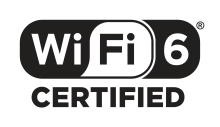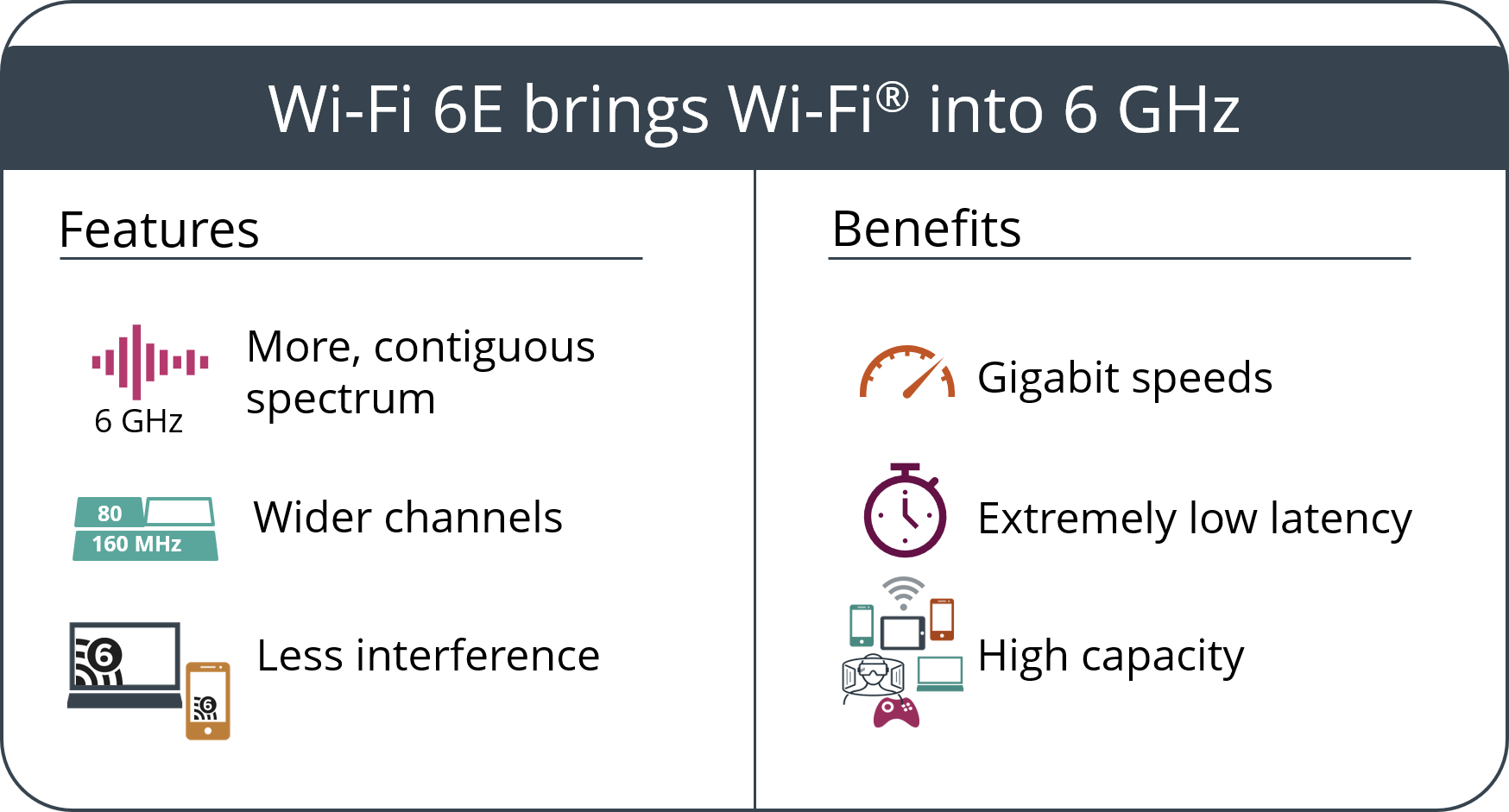
Capacity, efficiency, and performance for advanced connectivity
Wi-Fi CERTIFIED 6®, the industry certification program based on the IEEE 802.11ax standard, provides the capacity, efficiency, coverage, and performance required by users today in the most demanding Wi-Fi® environments. Emphasizing quality connectivity in locations with hundreds or thousands of connected devices such as stadiums and other public venues, as well as corporate networks utilizing time sensitive, high bandwidth applications, Wi-Fi CERTIFIED 6 networks ensure each connected device performs at an optimum level. Wi-Fi CERTIFIED 6 devices meet the highest standards for security and interoperability, and enable lower battery consumption, making it a solid choice for any environment, including the Internet of Things (IoT).
Key benefits of Wi-Fi CERTIFIED 6 technology include:
- Higher data rates
- Increased capacity
- Performance in environments with many connected devices
- Improved power efficiency
Wi-Fi CERTIFIED 6 provides the foundation for a host of current and emerging uses from streaming ultra high-definition movies, to mission-critical business applications requiring high bandwidth and low latency, to staying connected and productive while traversing large, congested networks in airports and train stations.
Wi-Fi 6E extends Wi-Fi CERTIFIED 6 into 6 GHz
 Wi-Fi operation in the 6 GHz frequency band enables Wi-Fi to continue delivering positive experiences for the most bandwidth intensive applications. Wi-Fi 6E certification as part of Wi-Fi CERTIFIED 6 offers the features and capabilities of Wi-Fi 6, extended to the 6 GHz band. Several nations around the globe are making the 6 GHz band available for unlicensed use, and Wi-Fi CERTIFIED 6 provides worldwide interoperability certification for devices in these markets.
Wi-Fi operation in the 6 GHz frequency band enables Wi-Fi to continue delivering positive experiences for the most bandwidth intensive applications. Wi-Fi 6E certification as part of Wi-Fi CERTIFIED 6 offers the features and capabilities of Wi-Fi 6, extended to the 6 GHz band. Several nations around the globe are making the 6 GHz band available for unlicensed use, and Wi-Fi CERTIFIED 6 provides worldwide interoperability certification for devices in these markets.
Wi-Fi 6E can utilize up to 14 additional 80 MHz channels or seven additional superwide 160 MHz channels in 6 GHz for applications such as high-definition video streaming and virtual reality. Wi-Fi 6E devices leverage these wider channels and additional capacity to deliver greater network performance and support more Wi-Fi users at once, even in very dense and congested environments. Wi-Fi 6E will bring greater technology advancements in Wi-Fi that will introduce new use cases, such as unified communications, cloud computing, and telepresence, and accelerate the next generation connectivity with 5G networks.
Wi-Fi 6E and incumbent devices
Wi-Fi Alliance seeks global harmonization of 6 GHz spectrum to ensure the performance of Wi-Fi devices in 6 GHz spectrum all over the world. To accomplish this goal, it is important that Wi-Fi and incumbent devices utilizing the 6 GHz band can successfully coexist.
Wi-Fi Alliance is leading the development of specifications, test plans, and training modules to enable the implementation of 6 GHz standard power devices under the control of the AFC system, ensuring that standard power Wi-Fi devices operate in 6 GHz spectrum under favorable conditions, avoiding interference with incumbent devices. In the U.S., the Federal Communications Commission (FCC) requires that unlicensed devices in standard power in the 6 GHz spectrum band are controlled by an Automated Frequency Coordination (AFC) system to protect incumbent operations. To achieve this, Wi-Fi Alliance added testing protocols to Wi-Fi CERTIFIED 6 to support the regulatory authorization process of 6 GHz standard power devices pursuant to recently published FCC guidance. The release of this new testing allows product vendors and service providers to verify that 6 GHz standard power devices meet the technical requirements of the FCC rules pertaining to operations under the control of the AFC system to more efficiently complete their regulatory testing.
Certification for Wi-Fi 6E devices, as part of Wi-Fi CERTIFIED 6, helps ensure products meet high standards for interoperability, security, and a range of application-specific protocols, and also promotes worldwide innovation and a diverse 6 GHz ecosystem. With the new standard power device testing capability, members can leverage nine Wi-Fi Alliance accredited Authorized Test Laboratories (ATL) – that are also FCC-recognized accredited test labs – to efficiently complete regulatory testing of their 6 GHz standard power devices and ensure their devices meet high Wi-Fi CERTIFIED™ standards.
For more information 6 GHz AFC resources, please visit: https://www.wi-fi.org/discover-wi-fi/6-ghz-afc-resources.
Innovation and performance in challenging environments
The ubiquity of Wi-Fi and its ability to complement other wireless technologies helps bring the promise of connecting everyone and everything, everywhere, closer to reality. Wi-Fi popularity has also created very diverse and densely populated Wi-Fi conditions, requiring technological advances to meet the needs of users. Wi-Fi CERTIFIED 6 delivers improvements and new features that enable Wi-Fi devices to operate efficiently in the most dense and dynamic connectivity settings.
Key capabilities:
- Orthogonal frequency division multiple access (OFDMA) effectively shares channels to increase network efficiency and lower latency for both uplink and downlink traffic in high demand environments
- Multi-user multiple input, multiple output (multi-user MIMO) allows more data to be transferred at one time, enabling access points (APs) to concurrently handle more devices
- 160 MHz channel utilization capability increases bandwidth to deliver greater performance with low latency
- Target wake time (TWT) significantly improves network efficiency and device battery life, including IoT devices
- 1024 quadrature amplitude modulation mode (1024-QAM) increases throughput for emerging, bandwidth intensive uses by encoding more data in the same amount of spectrum
- Transmit beamforming enables higher data rates at a given range to increase network capacity
Wi-Fi CERTIFIED 6 devices bring enhanced performance to emerging applications such as virtual and augmented reality used in e-Learning, telepresence, and healthcare. Wi-Fi CERTIFIED 6 also provides carriers and public Wi-Fi operators with more capabilities to support advanced connectivity in retail, stadiums, and transportation hubs, including a growing array of location-based applications and services.


